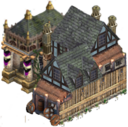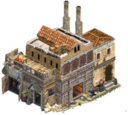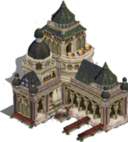Serbians/History
| Faction Overview | Strategic Overview | History |
|---|
History
Modern Serbia can trace its roots to a small state called Rascia which emerged during the early 8th century. Christianity arrived in the 9th century, but until the 13th century Rascia was a vassal of the Byzantine Empire. Following independence from Byzantium, the 13th and 14th centuries were the golden age of Serbia, which saw great prosperity and expansion but the late 14th century saw a new threat to Serbia — the Ottoman Turks. Following a string of military defeats culminating in the costly battle of Kosovo in 1389, the Turks annexed most of the Serbian lands. With Hungarian assistance, Serbian resistance continued to persist but the Serbs were mostly unsuccessful. Serbia would remain part of the Ottoman Empire until the 19th century when she could emerge independent once more.
Rascia
By the 7th century, a tribe of Slavs were allowed by the Eastern Roman Emperor Heraclius to settle in the Balkan highlands. These were the ancestors of the Serbs. Byzantine sources of the 8th century state that a certain Archon (in Greek, "overlord") emerged dominant over his neighbours and founded the state of Rascia, centred around the city of Ras (centred around Stari Ras, near the village of Raška in present-day Serbia). Legend holds that this man was named Visešlav. By the 10th century, this small state had embraced the Orthodox Christianity of its larger Bulgar and Byzantine neighbours, and was even recognised by the Byzantine Empire.
Despite this, however, Rascia's existence was tenuous. To the north lay the Catholic Holy Roman (or as Voltaire would say, German) Empire, and a Turkic tribe known as the Magyar, the scions of Hungary. Another Turkic tribe, the Bulgars menaced Serbia from Thrace in the east while the Byzantine Empire was also involved in intrigues against Serbia. Worse than these, however, was the latent dissension among the heirs of Visešlav and their own heirs, which threatened the very freedom of the Serbs. Upon the death of Časlav in the mid-10th century, Rascian unity was compromised and the polity was carved up by its neighbours, most notably the Byzantines. who annexed Ras and surrounding areas for themselves, while the Bulgars under Simeon I inducted the remaining parts of Rascia into his now expanding imperium.
Byzantine domination
For the next few generations after the death of Prince Časlav, Serbia would be in a foment and contested between the Byzantines and the Bulgars (who were heavily influenced by the "Roman" culture of Byzantine, and had inherited Caesar's appetite for conquest too). Serbia thus became a heavily disputed frontier between both the Byzantines and the Bulgars, and thus would remain so as long as both the Byzantines and Bulgars had money and men to expend in defence of their conquests. This trial of blood was settled in the early 11th century with Basil II's conquest of Bulgaria in 1018, settling the question of the overlordship of Serbia once and for all in the favour of the Byzantine Empire.
De facto Byzantine rule in Serbia was to last for almost a century, and Ras was reorganised as a capetanate or "captaincy", with a Byzantine military governor in charge. Too little written evidence remains to explain what life may have been like, but what is not in dispute is that Byzantine domination enriched Serbian culture. The many Byzantine-styled cathedrals as well as the trappings of Eastern Roman court protocol and church services are all testimony to just how much was absorbed from Byzantium, but perhaps more importantly, especially for mediaeval Serbia, was the adoption of Roman-styled jurisprudence through both government and religion in later centuries which may have helped post-Byzantine Serbian rulers better in consolidating and exercising power.
By the mid-11th century, the Byzantines were in trouble, and were facing a slew of enemies, among which the most dangerous were the Turks. The Bulgars, once subjects of the Byzantines, were also baring their teeth, and the empire faced the depredations of Pechenegs in Asia, while a new race of invaders from Western Europe called the Normans had established themselves in Italy. In the wake of weakening Byzantine authority, one Serbian nobleman, Stefan Vojislav of Doclea, chose to rebel and eventually seized the southwestern Adriatic coast as well as the ancient city of Ras.
The Long Road to Royal Rule
The rule of Stefan Vojislav of Doclea and those of his heirs, the Vojislavevici, was quite illustrious. Several of his descendents managed to marry into Byzantine nobility and establish dynastic relations with the Italian Normans, while his great-grandson Constantine Bodin even briefly became the Tsar of Bulgaria following a revolt in Bulgarian Macedonia.
However, Doclean hegemony in Serbia was not to last. Early on, Constantine Bodin had installed a distant relative named Vukan as the head or ban of Rascia. Following the death of Constantine Bodin in 1108, Vukan was left as the most powerful man in Serbia and he and his descendents, the Vukanovici, managed to continue to consolidate their rule by establishing relations with the Italians and the Hungarians, while fending off Bulgarian and Byzantine intentions on Serbia.
Pride, Power, and Perdition
Even so, the Byzantine empire remained both a threat and opportunity to Serbian intentions. A brief power struggle orchestrated by the Byzantines in the late 12th century resulted in the replacement of the lord or archon Tihomir with a relative, Stefan Nemanja, despite initial efforts by the Byzantines to undermine Stefan. It was thought that Tihomir had displeased Constantinople sufficiently that the Byzantines then chose to sponsor Nemanja instead.
Whatever the reasons for Tihomir's supplantation and subsequent death at the hands of Stefan Nemanja, Serbia was now finally evolving from a tenuous tribal confederacy to a modern and centralised polity. Although he wielded no political influence, Stefan Nemanja's son, Rastko, became a monk and subsequently took on the name Sava after Saint Sabbas of Palestine. Sava contributed much to Serbia and even drafted a constitution for Nemanjic Serbia, and for this he was later canonised as an Orthodox Christian saint. Serbian confidence could be seen in how Serbia was first declared a kingdom in 1217, and then an empire and a successor to the now moribund Byzantines in 1345. At the height of Serbian power during the rule of Stefan Uros IV, nicknamed "Dusan the Mighty" in the mid-14th century, Serbia covered an area comprising not just modern Serbia alone, but the regions comprising present-day Montenegro, Kosovo as well as present-day Macedonia (not the former Greek kingdom of Macedon) and northern Greece. Serbia prospered from trade along the Adriatic and was sufficiently powerful to even challenge the more powerful Hungarians to the north, even as its former adversary, the Byzantine empire, withered and fell apart.
However, things would not last. As easily as it took the Vukanovici and the Nemanjici to construct the empire, it too soon speedily fell. Tsar Stefan Uros IV had the misfortune of having a son, Stefan Uros V, who was soon known as "the weak". Whether it was because of his lack of competence or because of the difficulties in consolidating the many conquests of his father, what is certain however was that by the end of his life, Serbia began to disintegrate into feudal anarchy, spurred on by military defeats with the Turks.
Turkish Occupation
The destruction of most of the Serbian army in September 1371 at Maritsa and the subsequent death of Stefan Uros V without issue later that year saw the southern provinces of Serbia being annexed by the Ottomans, sealing Serbia's fate. Any hope of remaining independent was soon crushed at the costly battle of Kosovo in 1389 (in which both the Ottoman Sultan and the Serbian lords were killed). The Serbians were by now little more than de facto viceroys for the Hungarian crown in the Balkans, but they would hold out as masters of their own lands before being extinguished by the Ottomans with the 1521 siege of Beograd. Revolts broke out against Ottoman rule, however, but they would be stamped out bloodily and even resulted in the destruction of Saint Sava's relics by the Turkish authorities to discourage further rebellion. Thus, Serbia would remain part of the Ottoman colossus in Europe until its own disintegration at the onset of the mid-19th century.
Trivia
The Serbians sometimes stand in as the Bulgars, especially in the Late CtW — which is appropriate as Serbia and Bulgaria once shared common ties during the High Middle Ages.


